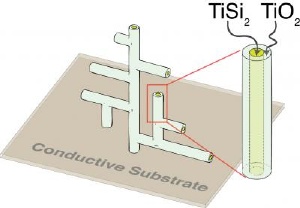Mar 3 2009
Overcoming a critical conductivity challenge to clean energy technologies, Boston College researchers have developed a titanium nanostructure that provides an expanded surface area and demonstrates significantly greater efficiency in the transport of electrons.
 An illustration of a titanium nanostructure grown by researchers from Boston College, who report the material is capable of providing expanded surface area and improved conductivity, two qualities seen as critical in the search for clean energy technologies. Credit: Journal of the American Chemical Society
An illustration of a titanium nanostructure grown by researchers from Boston College, who report the material is capable of providing expanded surface area and improved conductivity, two qualities seen as critical in the search for clean energy technologies. Credit: Journal of the American Chemical Society
The challenge has vexed researchers pursuing solar panels thick enough to absorb sunlight, yet thin enough to collect and transport electrons with minimal energy loss. Similarly, the relatively new science of water splitting requires capturing energy within semiconductor materials and then efficiently transporting charges ultimately used to generate hydrogen.
Boston College Asst. Prof of Chemistry Dunwei Wang and members of his lab found that incorporating two titanium-based semiconductors into a nano-scale structure improved the efficiency of power-collecting efforts by approximately 33 percent, the team reported in the online edition of the Journal of the American Chemical Society.
The team achieved a peak conversion efficiency of 16.7 percent under ultraviolet light, reported Wang and his co-authors, BC graduate students Yongjing Lin and Sa Zhou, post doctoral researcher Xiaohua Liu and undergraduate Stafford Sheehan. That compared to an efficiency of 12 percent from a structure composed only of titanium dioxide (TiO2).
Wang said the efficiency gains within the novel material can serve so-called water-splitting, where semiconductor catalysts have been shown to separate and store hydrogen and oxygen gases.
"The current challenge in splitting water involves how best to capture photons within the semiconductor material and then grab and transport them to produce hydrogen," Wang says. "For practical water splitting, you want to generate oxygen and hydrogen separately. For this, good electrical conductivity is of great importance because it allows you to collect electrons in the oxygen-generation region and transport them to the hydrogen-generation chamber for hydrogen production."
By using two crystalline semiconductors – materials critical to the processes of energy capture and transport – Wang says the researchers discovered a new and successful transfer mechanism in an engineered structure nearly invisible to the human eye.
Titanium dioxide has played a key role in early water-splitting research because of its prowess as a catalyst. However, its light absorption is confined to ultraviolet rays only and the material is also a relatively poor conductor.
Wang and his researchers started by growing a nanostructure made of titanium disilicide (TiSi2), a semiconductor capable of absorbing solar light and a material able to provide a sturdy structure with expanded surface area critical to absorbing photons. Still in need of its catalytic capabilities, titanium dioxide was used to coat the structure, Wang said.
The resulting net-like nanostructure effectively separated charges, collecting the electrons in the titanium disilicide core and transporting them away. The structure transferred positive charges to the titanium dioxide region of the material for chemical reactions. In water-splitting, these charges could potentially be used to generate hydrogen.